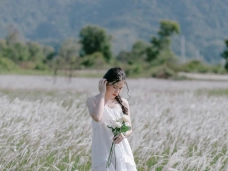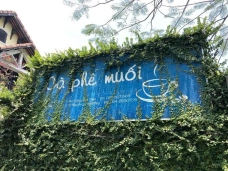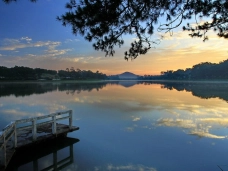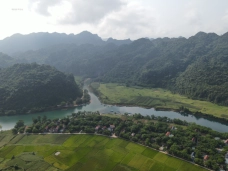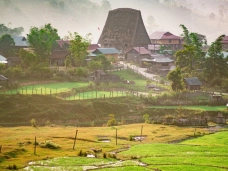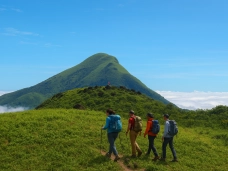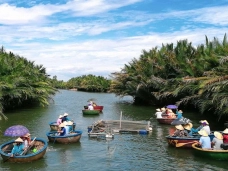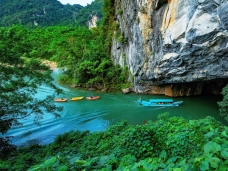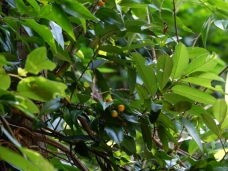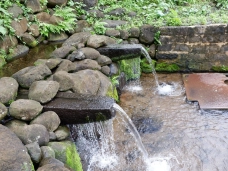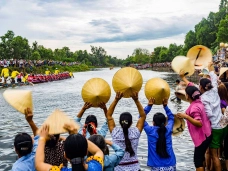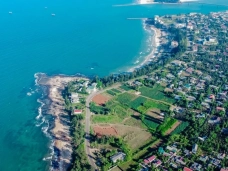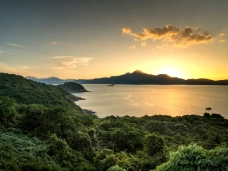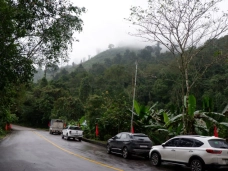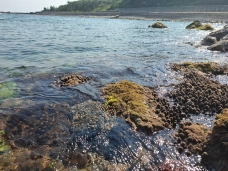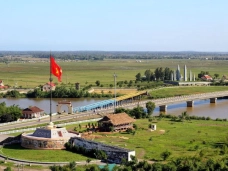Bạch Mã – Where Nature Awakens
06-06-2024 18:17
I first knew about Bạch Mã in the 1990s, during a visit to a friend's hometown. From afar, Bạch Mã appeared as an endless expanse of green, majestic and draped in morning mist, with clouds gathering to create a mesmerizing landscape painting. This time, our visit to Bạch Mã was not for leisure but to explore new efforts in preserving its natural values. We were scheduled to visit various scenic spots and explore the area. Bạch Mã boasts a cool climate, magnificent scenery, and diverse ecosystems. During this warm trip with colleagues and the charm of nature, I was inspired to write a piece to cherish the nature and appreciate the people here.

Visiting Đỗ Quyên Waterfall - unfortunately, it started to rain.
The name “Bạch Mã”
During a trip to Hải Vọng Đài at the peak of Bạch Mã to hunt for clouds, watch the sunset, and enjoy the scenery, I was informed by our guide, Mr. Dân, that the name "Bạch Mã" originated from the image of the high peaks of the Trường Sơn range, covered in clouds and mist, resembling white horses galloping in the sky. This name not only has a vivid imagery but also reflects the majestic and poetic beauty of this area. From the summit of Bạch Mã, you might not see the cloud formations like galloping horses, but looking out in all directions, you can truly appreciate the grandeur of nature - indeed a "magnificent landscape."
The origin of Bạch Mã
Bạch Mã has likely existed for millions of years, with towering mountains, dense forests, and abundant wildlife. Many might have known about it long before. Searching through history, in "Ô Châu Cận Lục" compiled in 1553 by Dương Văn An, it describes "a famous mountain with beautiful scenery covered by white clouds, creating the image of white horses floating in the blue sky." In the "Đại Nam Nhất Thống Chí," a geographic book by the Nguyễn Dynasty's historical office in the 19th century during Emperor Tự Đức's reign, it documents the geographic location, scenery, and cultural and historical value of the mountain, emphasizing Bạch Mã's importance in the geographical and cultural context of Thừa Thiên Huế province.

The view from the peak of Bạch Mã
Continuing the story of those who discovered Bạch Mã, Mr. Trương Cảm (nicknamed the bird caller), shared that Bạch Mã's history is linked to French naturalist Jean Theodore Delacour and Dr. Pierre Jabouille, who discovered the Edwards's pheasant (Lophura edwardsi) in 1923, a rare endemic bird of Vietnam, found in Bạch Mã and nearby areas. This marked the beginning of a deeper exploration of the natural values and landscape of this region.
The ups and downs of Bạch Mã
Beginnings
In the late 1920s, a French engineer named M. Girard discovered Bạch Mã, attracted by its cool climate and beautiful scenery. Recognizing its potential for tourism, he proposed turning the area into a resort for officials and French residents in Vietnam. In 1932, the construction project of Bạch Mã resort officially began, supervised by the French colonial administration.
Golden era
During the 1930s and 1940s, Bạch Mã thrived with the emergence of many luxurious villas. At its peak, about 139 villas were built. These villas, with French architectural style, were interspersed among the natural forest landscape, creating an ideal resort. The villas were designed to maximize the advantages of Bạch Mã’s terrain and climate, with spacious gardens, balconies overlooking the mountains, and natural ventilation systems.
Decline and abandonment
After World War II and throughout the Vietnam War, Bạch Mã suffered significant damage. The villas were abandoned, deteriorated due to lack of maintenance, and were ravaged by war. After the country reunified in 1975, the area remained neglected for a long period.
Revival and conservation
In the late 1980s and early 1990s, the Vietnamese government recognized the historical value and tourism potential of Bạch Mã. In 1991, Bạch Mã National Park was established, marking the beginning of the area's restoration and conservation. The old villas began to be restored and preserved to retain their historical and cultural values.
Today, many villas in Bạch Mã have been restored and converted into resorts, restaurants, and tourist attractions. These villas are not only a testament to a historical period but also a significant highlight in the journey to explore Bạch Mã, attracting both domestic and international visitors.
Bạch Mã National Park, established in 1991, is located in Thừa Thiên Huế province, central Vietnam. The park was created to protect and restore rare and diverse flora and fauna along with its rich ecosystems.
Bạch Mã – a natural treasure
Bạch Mã covers an area of about 37,487 hectares and is known for its temperate climate, cool all year round. It has a rich system of rivers and streams, with lush vegetation covering both primary and secondary forests. The average annual temperature here ranges from 19-21°C, providing ideal conditions for the growth of many plant and animal species.
The Bạch Mã mountain range has been influenced by various tectonic activities, including the collision of tectonic plates and faults. These activities have formed a complex and diverse geological structure in the area. Tectonic faults in this region have also contributed to the creation of streams, waterfalls, and natural lakes, shaping the distinctive landscape of Bạch Mã National Park.
Bạch Mã is part of the Trường Sơn geological zone, a segment of the Indochinese geological system. The Trường Sơn zone stretches from North Central to Central Vietnam, including Thừa Thiên Huế, where Bạch Mã is located. Bạch Mã is mainly composed of metamorphic rocks such as gneiss, schist, and quartzite, along with sedimentary and granite rocks. These rocks have undergone intense metamorphism and have been uplifted to the surface through geological tectonic activities over millions of years. This geological structure has created high peaks, deep valleys, and streams, influencing the distribution and diversity of vegetation.

White-browed Laughingthrush - Trương Cám
The terrain of Bạch Mã is primarily mountainous, ranging from 40 meters to 1,450 meters above sea level. The sudden changes in elevation create diverse landscapes, from high mountain ranges and narrow valleys to waterfalls and natural lakes. The highest peak is Bạch Mã summit, at 1,450 meters, offering a stunning panoramic view.
The soil in Bạch Mã is mainly yellow-red feralit soil developed on granite and metamorphic rocks. This type of soil is highly fertile, suitable for the growth of tropical and subtropical forests. The rich and diverse flora of Bạch Mã is partly due to the high soil quality and favorable climatic conditions.
Bạch Mã has a rich system of rivers and streams, with many large and small streams flowing through the mountains and valleys. The water from these streams flows into natural lakes like Ngũ Hồ and creates magnificent waterfalls like Đỗ Quyên Waterfall. These hydrological features not only enhance the natural landscape but also play a crucial role in maintaining the area's diverse ecosystem.
Bạch Mã is famous for its majestic landscapes and rich biodiversity. It is home to over 2,000 plant species, including many rare species. During our trip, we witnessed some rare species such as Pseudotsuga sinensis, Podocarpus neriifolius, Pinus krempfii, and Amentotaxus argotaenia, nestled among the evergreen tropical forest vegetation. The area is also known as a safe habitat for over 1,700 animal species, including many rare species like the white-cheeked gibbon, red-shanked douc, and Asiatic black bear.
The bird caller
During our two-day work trip in Bạch Mã, Mr. Trương Cảm helped us learn a lot about the birds here. Although he used to trap wild birds and catch stream fish, realizing the destructive impact on nature, he was transformed and became a forest ranger to protect the forest and life in this beautiful place. He knows more about the birds here than anyone else, from nesting and laying eggs to their habitats and food. Whenever he calls out, the birds chirp back, filling the tranquil forest with sound.
Like humans, each bird species has its own language. Trương Cảm seems to understand the language of many bird species here because whenever he calls, they respond. This truly amazed us. For species in the wild, when we cherish and protect them, they become our close friends – a valuable lesson not only for conservationists but for all of us.
Where to go in Bạch Mã
Bạch Mã also has a beautiful system of waterfalls like Đỗ Quyên Waterfall and Trĩ Sao Waterfall, along with clear streams flowing through mountain crevices. This not only creates a majestic natural landscape but also provides an ideal habitat for aquatic species.
Bạch Mã summit: At 1,450 meters high, Bạch Mã summit is the perfect spot to view the national park and the East Sea from afar. The trail to the summit is covered with dense forest and full of flowers, offering an exciting hiking experience.
Ngũ Hồ: This system of five natural lakes stands out with its pristine scenery and clear blue water. It's an ideal place for visitors to relax and swim.
Đỗ Quyên Waterfall: With a height of about 300 meters, Đỗ Quyên Waterfall is one of the most beautiful waterfalls in Bạch Mã. The waterfall is named after the azalea flowers growing around the area, creating a poetic and romantic scene.
Hải Vọng Đài: This observation tower was built during the French colonial period, offering visitors a panoramic view of the national park and the vast sea.
Bạch Mã is not only an ideal destination for nature lovers but also a cultural and historical treasure. From towering peaks and cool streams to rare plant and animal species, Bạch Mã is a vivid testament to the diversity and richness of Vietnam's ecosystem. The combination of natural beauty and historical value has made Bạch Mã an unmissable destination. Visit Bạch Mã to feel the majestic and poetic beauty of this land and contribute to protecting and preserving the priceless values that nature has bestowed upon us."
Comments
Comments (Total 0)
Related Articles
26-11-2025
Khe Sanh – A Journey into Memory
05-11-2025
8 Unmissable Instagram Spots in Da Lat
28-10-2025
Beneath the Arch of Scarlet Blossoms
31-07-2025
Son Tra Awaits
30-04-2025





